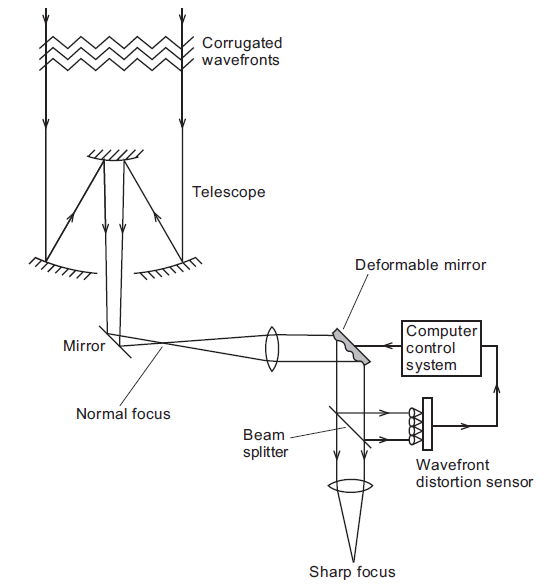
تاريخ الفيزياء

علماء الفيزياء


الفيزياء الكلاسيكية

الميكانيك

الديناميكا الحرارية


الكهربائية والمغناطيسية

الكهربائية

المغناطيسية

الكهرومغناطيسية


علم البصريات

تاريخ علم البصريات

الضوء

مواضيع عامة في علم البصريات

الصوت


الفيزياء الحديثة


النظرية النسبية

النظرية النسبية الخاصة

النظرية النسبية العامة

مواضيع عامة في النظرية النسبية

ميكانيكا الكم

الفيزياء الذرية

الفيزياء الجزيئية


الفيزياء النووية

مواضيع عامة في الفيزياء النووية

النشاط الاشعاعي


فيزياء الحالة الصلبة

الموصلات

أشباه الموصلات

العوازل

مواضيع عامة في الفيزياء الصلبة

فيزياء الجوامد


الليزر

أنواع الليزر

بعض تطبيقات الليزر

مواضيع عامة في الليزر


علم الفلك

تاريخ وعلماء علم الفلك

الثقوب السوداء


المجموعة الشمسية

الشمس

كوكب عطارد

كوكب الزهرة

كوكب الأرض

كوكب المريخ

كوكب المشتري

كوكب زحل

كوكب أورانوس

كوكب نبتون

كوكب بلوتو

القمر

كواكب ومواضيع اخرى

مواضيع عامة في علم الفلك

النجوم

البلازما

الألكترونيات

خواص المادة


الطاقة البديلة

الطاقة الشمسية

مواضيع عامة في الطاقة البديلة

المد والجزر

فيزياء الجسيمات


الفيزياء والعلوم الأخرى

الفيزياء الكيميائية

الفيزياء الرياضية

الفيزياء الحيوية

الفيزياء العامة


مواضيع عامة في الفيزياء

تجارب فيزيائية

مصطلحات وتعاريف فيزيائية

وحدات القياس الفيزيائية

طرائف الفيزياء

مواضيع اخرى
Adaptive optics
المؤلف:
A. Roy, D. Clarke
المصدر:
Astronomy - Principles and Practice 4th ed
الجزء والصفحة:
p 333
28-8-2020
2297
Adaptive optics
The atmosphere in the light path above a telescope distorts the incoming wavefronts with the image definition fluctuating at a rate of about 100 times a second. At any one instant, to a first order, over a large telescope diameter, the wavefront corrugations can be considered to comprise a number of plane sections with dimensions of the order of the Fried parameter, r0, but with a random set of tilts. Substantial correction of the blurring that this introduces could be achieved by sensing the deformations, taking note of each of the locations of the plane sections, and applying compensating tilts so that the whole of the wavefront becomes planar again. Such fast correcting optics are referred to as adaptive optics (AO) systems.
One possible way of doing this would be to consider making the elements of any mosaic telescope to be of a size no larger than r0. If the locations and tilts of the disturbed sections of the original plane wavefront could be continuously monitored, elaborate feedback systems might be designed to control the individual pieces of the mosaic so that elemental tilt corrections could be applied.
Although the concept is sound, its implementation cannot be effected directly in this way. The behaviour of seeing requires the response times of the mosaic elements to be no longer than a few milliseconds. Because of the substantial weight of each mosaic cell, their large inertias prevent adjustments on such timescales.
The problem can be addressed, however, by designing the AO with lightweight elements. One such scheme is shown in simplified form in figure 1. Following the normal focus of the telescope, the light beam is collimated and then reflected off a deformable mirror at a position such that the collimator produces an image of the telescope aperture on it. At this position the effective size of r0 is reduced or demagnified by the ratio of the diameter of the telescope to that of the collimated beam.

Figure 1. A schematic layout of an adaptive optics system.
Subsequent to the reflection, part of the beam is deflected to a wavefront distortion sensor but with the greater part of the flux brought to a focus where the astronomical data are collected. One form of sensor is a fast readout CCD with lenslets prior to the pixels, so producing an image of the field on the chip. On successive readouts, a computer control system constantly provides signals to the activators controlling the shape of the small deformable mirror. This mirror may be constructed from small plane mirrors such that their individual sizes are no larger than the demagnified value of r0, with each element controllable in tilt by piezo-electric pistons. Thus, the plane sections within the original broad diameter beam illuminating the telescope are realigned to produce a collimated beam with the greater part of the wavefront disturbances corrected. Much sharper images are then found at the chief focus for applying long exposure cameras or other analysing instruments for data collection. By improving the Strehl index, for example, more of the flux collected by a large telescope diameter can be made to pass through the entrance slit of an attached spectrometer. Alternative schemes for sensing the seeing involve the production of ‘artificial stars’ by application of powerful lasers to illuminate the regions of the atmosphere where the turbulence occurs and to assess the deformations by recording the returned scattered light.
For most kinds of observation, it is important to have adaptive optics as a standard feature on all large telescopes. AO systems were automatically considered in the design of the twin 8 m Gemini telescopesW 20.4. Gemini North is located on Mauna Kea, Hawaii, at a height of 4200 m, Gemini South is on Cerro Pachon, Chile, at an altitude of 2715 m. While the performances of both giant telescopes depend upon their being at such great heights that much of the Earth’s atmosphere is below them, their success in producing images as sharp as the Hubble Space Telescope’s images also depends on their AO operating systems.
 الاكثر قراءة في مواضيع عامة في علم الفلك
الاكثر قراءة في مواضيع عامة في علم الفلك
 اخر الاخبار
اخر الاخبار
اخبار العتبة العباسية المقدسة

الآخبار الصحية















 قسم الشؤون الفكرية يصدر كتاباً يوثق تاريخ السدانة في العتبة العباسية المقدسة
قسم الشؤون الفكرية يصدر كتاباً يوثق تاريخ السدانة في العتبة العباسية المقدسة "المهمة".. إصدار قصصي يوثّق القصص الفائزة في مسابقة فتوى الدفاع المقدسة للقصة القصيرة
"المهمة".. إصدار قصصي يوثّق القصص الفائزة في مسابقة فتوى الدفاع المقدسة للقصة القصيرة (نوافذ).. إصدار أدبي يوثق القصص الفائزة في مسابقة الإمام العسكري (عليه السلام)
(نوافذ).. إصدار أدبي يوثق القصص الفائزة في مسابقة الإمام العسكري (عليه السلام)


















